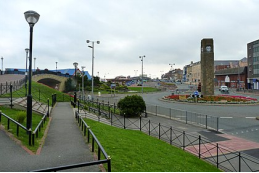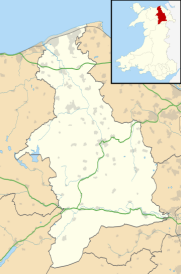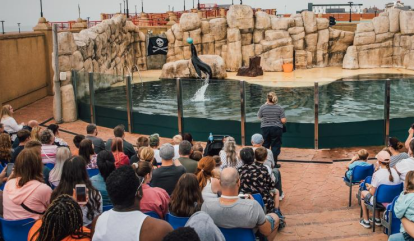Rhyl, Denbighshire, Wales, UK 作者: 来源: 发布时间:2021-09-17
I. Population and Area
Continent: Europe
Country: The U.K
State/Province: Wales
City/Town: Rhyl, Denbighshire
Total Area: 3.452 (sq mi)
Population in 2011: 25.14 (thousand)

II. Natural Geography (environment and resources)
Climate
The climate is cool and temperate in Rhyl. The climate here is classified as Cfb by the Köppen climate classification. The average temperature in Rhyl is 9.3 °C (48.7 °F). Annual precipitation averages 794 mm (31.3 in).
Transport
Rhyl railway station on the North Wales Coast Line is served by through trains of Avanti West Coast between Holyhead and London Euston, and by Transport for Wales services: to Cardiff Central via Newport and Crewe, and to Manchester Piccadilly. Other stations nearby include Abergele & Pensarn, Prestatyn, Flint, Colwyn Bay and Llandudno Junction. The direct Transport for Wales and Avanti West Coast services to Holyhead give connections by Stena Line or Irish Ferries to Dublin Port. The A548 road through the town links with the A55 Holyhead to Chester road at Abergele. The A525 road runs south from the town to Rhuddlan, St Asaph and Ruthin. Several Arriva Buses Wales bus services are run along the main coast road between Chester and Holyhead, linking the resorts. Another route runs between Rhyl and Denbigh.
Geography
The eastern border of Denbighshire follows the ridge of the Clwydian Range, with a steep escarpment to the west, and a high point at Moel Famau (1,820 ft (555 m)). The Clwydian Range is, with the upper Dee Valley, an Area of Outstanding Natural Beauty – one of just five in the whole of Wales. The Denbigh Moors (Mynydd Hiraethog) are in the west of the county and the Berwyn Range adjacent to the southern boundary. The River Clwyd in its broad, fertile Vale runs from south to north in the centre of the county. There is a narrow coastal plain in the north where there is much residential and tourist development. The highest point in the historic county is Cadair Berwyn (height 832 m or 2,730 ft), though border changes since 1974 make Cadair Berwyn North Top (height 827 m or 2,713 ft) the high point of the current council area. Denbighshire borders the counties of Conwy, Flintshire, Wrexham, and Powys.

III. ECONOMY
Average Salary in Rhyl, Wales: Denbighshire £24k


About Rhyl, Wales: Denbighshire
The average salary in Rhyl, Wales: Denbighshire is £24k. Trends in wages decreased by -100.0 percent in Q3 2020. The cost of living in Rhyl, Wales: Denbighshire is 100 percent higher than the national average. The most popular occupations in Rhyl, Wales: Denbighshire are Teaching Assistant (TA), Staff Nurse, and Project Manager, (Unspecified Type / General) which pay between £16k and £39k per year.
Anglesey has the lowest economic value in the UK, but Gwynedd is one of the fastest growing - according to figures released today. The lowest Gross Value Added per head in the UK is found on Anglesey, at £11,368, while Cardiff and the Vale of Glamorgan has the highest at £22,986, according to statistics from the Office for National Statistics. Gwynedd was the area in Wales with the the biggest growth in GVA between 2012 and 2013, up 7% from £16,711 to £17,899. It was the joint fifth fastest growing area of the UK. However, Anglesey saw the worth of its economy shrink by 1.5% over the same period.
The island has seen major job losses with the closure of the Welsh Country Foods lamb abattoir and is still struggling to replace the hundreds of well paid jobs that went with the closure of the Anglesey Aluminium smelter in 2009.
Flintshire and Wrexham are the best performing part of North Wales, with a GVA per head of £19,422, with Conwy and Denbighshire having a GVA per head of £14,873.
Wales saw Gross Value Added (GVA) per head of population rise 3.4% between 2012 and 2013, the joint biggest rise with the North West. However, even the big increase leaves the area last in the UK, with GVA of £16,893. The UK average is £23,394.
Reference Website:
https://www.payscale.com/research/UK/Location=Rhyl-Wales%3A-Denbighshire/Salary
https://www.dailypost.co.uk/business/business-news/anglesey-worst-performing-part-uk-8263444
IV. Industrial Characterisitics
Major industries:
Since the 20th-century demise of the coal and steel industries in the Wrexham area, there are no heavy industrial sites in the county. Although most towns have small industrial parks or estates for light industry, the economy is based on agriculture and tourism. A high proportion of the working population is employed in the service sector. The uplands support sheep and beef cattle rearing, while in the Vale of Clwyd dairy farming and wheat and barley crops predominate. Many towns have livestock markets and the farming supports farm machinery merchants, vets, feed merchants, contractors and other ancillary trades. With their incomes on the decline, farmers have found opportunities in tourism, rural crafts, specialist food shops, farmers' markets and value-added food products.
Tourism is nowadays the main source of income. The upland areas with their sheep farms and small, stone-walled fields are attractive to visitors. Redundant farm buildings are often converted into self-catering accommodation, while many farmhouses supply bed and breakfast. The travel trade began with the arrival of the railway on the coast in the mid-19th century, opening up the area from Merseyside. This led to a boom in seaside guest houses. More recently, caravan sites and holiday villages have thrived and there has been an increase in ownership of holiday homes. Various initiatives to boost the economy of North Wales are in progress in 2016, including a redevelopment project for the former Rhyl seafront and funfair.
Major projects and related introductions:
Rhyl Regeneration
The Council is working with private sector development partners to transform the site into a vibrant mix of retail, food and beverage, contemporary market, office and residential space while improving accessibility from the waterfront and promenade into the town centre.
Plans also include an open courtyard and public space in the £30million plus development, which includes the former Savoy Hotel and Queen's Market buildings.
Due to the extremely poor state of the site, a significant number of the buildings in the Council’s ownership will need to be demolished.
Reference Website:
https://www.denbighshire.gov.uk/en/community-and-living/regeneration/rhyl-regeneration/rhyl-regeneration-page.aspx
V. Attractions
1. Rhyl SeaQuarium:

Tread in the footsteps of ancient royalty by following part of the Offa's Dyke Path. This national 177-mile walking trail was named after King Offa, the Mercian King responsible for a dyke built between England and Wales in the 8th century. Follow the route across the Prestatyn Hillside before dropping down into the town itself.
2. Beaches, Rhyl and Prestatyn:

If you are looking to spend some quality family time making sandcastles, or just want a walk to take in the sea air, you will find plenty of wide open spaces here. The beaches of both Rhyl and Prestatyn boast miles of beautiful sand and are ideal for all the family. You can take a dip in the zoned bathing areas where lifeguards are present from mid-May to early September.
3. Rhyl Miniature Railway:

Billy, Clara, and the Railway Queen are among the beautiful old engines at the Rhyl Miniature Railway, where regular steam train departures snake past the tranquil Marine Lake. More than a century after the station opened, you can still enjoy a ride before relaxing and perusing the museum.
Reference Website:
https://www.visitwales.com/en-us/destinations/north-wales/north-east-wales/walks-rides-arts-and-beaches-things-do-prestatyn-and-rhyl
VI. History
Rhyl is a seaside resort and community in the Welsh county of Denbighshire. It lies within the historic boundaries of Flintshire, on the north-east coast of Wales at the mouth of the River Clwyd (Welsh: Afon Clwyd). To the west is the suburb of Kinmel Bay and the resort of Towyn beyond, to the east Prestatyn, and to the south Rhuddlan. At the 2011 Census, Rhyl had a population of 25,149, with Rhyl-Kinmel Bay having 31,229. The Abergele–Rhyl–Prestatyn conurbation numbers over 60,000. Once an elegant Victorian resort, an influx from Liverpool and Manchester after the Second World War changed the town's face. It had declined sharply by 1990, but has since been improved by major regeneration investments. Several million pounds of European Union funding secured by the Welsh Government has been spent on developing the seafront.
Early documents refer to a dwelling in the area named Ty'n Rhyl, and a manor house with that name still exists in the town. However, the etymology of the word Rhyl has been the subject of debate for more than a century.
Welsh orthography has proved difficult for English writers to translate, and Rhyl's opening voiceless alveolar trill is uncommon in the English language (represented in modern Welsh by the digraph 'Rh'). As such the name has appeared in English texts as Hulle (1292), Hul (1296), Ryhull (1301), Hyll (1506), Hull (1508), yr Hyll (1597), Rhil (1706), Rhûl (1749), Rhul (1773) Rhyll (1830), and Rhyl (1840).
One suggested hybrid etymology is the use of an unfamiliar English word ("hill") in Welsh syntax (Yr Hyl becoming Yr Rhyl). This etymology is considered unlikely as the town was situated on coastal marshland, with no hills in the vicinity. Similarly, it has been suggested that the name may derive from 'Yr Heol' ("The Road/Street"), but again, the road this would refer to is unknown and the sound change may be problematic.
One popular theory suggests that the original dwelling of 'Ty'n Rhyl' derived from 'Tŷ'n yr haul' (House in the sun/House of Sunshine). This may be an example of folk etymology, as Rhyl gained popularity as a summer destination for Welsh-speaking tourists and was advertised in English and Welsh as Sunny Rhyl.
VII. Culture
Rhyl has a number of Grade II listed buildings and landmarks. These include the Parish Church of St Thomas in Bath Street, which is listed as Grade II. Others are the Midland Bank building, the railway station along with two signal boxes and the public telephone box on the up platform, the Royal Alexandra Hospital, the Sussex Street Baptist Church; the Town Hall; the Swan public house in Russell Road, the war memorial, and the Welsh Presbyterian Church in Clwyd Street.
Also notable is the Grade II listed Foryd Harbour Bridge, a blue bridge with distinctive bowstring girders built in 1932. Situated over the River Clwyd, it links Rhyl with Kinmel Bay.
Another landmark is the Church of St Margaret of Antioch. The Marble Church was built by Lady Margaret in memory of her late husband, Sir Henry Peyto Willoughby de Broke. It was completed within four years and consecrated on 23 August 1860, becoming the parish church of a new parish of Bodelwyddan, covering an area formerly in that of St Asaph. The church opens daily from 9:30 to 16:30, except between 25 December and 6 January.
A previous Rhyl landmark was the ornate Pavilion Theatre with five domes, which was demolished in 1974. Half a mile further down the promenade stood Rhyl Pier, opened in 1867 at 2,355 feet (718 m) long. The structure was damaged by ships in 1883 and again in 1891. It was further damaged in 1901 by fire. Storms were responsible for further damage in 1909 in 1913 was closed as unsafe. Although it reopened with a much-reduced length in 1930, it closed again in 1966 and was demolished in 1973.
Rhyl's top attractions on the West Parade are Rhyl Children's Village theme park, and the 250-foot (76 m) Sky Tower (formerly the Clydesdale Bank tower, brought to Rhyl from the 1988 Glasgow Garden Festival). The Sky Tower opened in 1989, but it was closed to the public in 2010 and transformed into an illuminated beacon in 2017。A VUE Cinema is also located there.
On the East Parade is the SeaQuarium. Up until 2014, Rhyl Suncentre was also an attraction on the East Parade; an indoor water leisure centre which opened in 1980 at a cost of £4.25 million and featured a heated swimming pool, water chutes and slides, and Europe's first indoor surfing pool. The local council closed the centre in early 2014 and it was demolished in 2016. A new Travelodge hotel was built next to the site, which opened in early 2019. A new indoor/outdoor water park, the SC2, opened further along the promenade in 2019, and includes various pools with water chutes and slides, as well as a separate "Ninja Tag" assault course game complex. Also on the East Parade is the New Pavilion Theatre, opened in 1991. It has over 1,000 seats and is managed by Denbighshire County Council. Redevelopment of the Pavilion theatre in 2017 provided for a new façade, entrance foyer and restaurant, and refurbished bar areas.
The Marine Lake, an artificial excavation in the west of the town, used to be a tourist destination, with fairground rides and a zoo. The lake is a 12-hectare man-made reservoir and it was officially opened in 1895. Rhyl Miniature Railway is the only original attraction remaining on the site, a narrow gauge railway that travels around the lake and is now based at the new museum and railway centre. There is also a playground and numerous watersports clubs based around the lake.
VIII. Other information
Pantomimes
For as long as can be remembered, ever since the New Rhyl Pavilion Theatre opened 30 years ago, there have been multiple pantomimes which include Dick Whittington, Peter Pan and Aladdin. Due to the COVID-19 pandemic in Wales, Cinderella (which was supposed to be held across December 2020) has been postponed until early December 2021.
Online Panto
Because of the initially planned panto delayed until next year, to avoid disappointment, Anton Benson Productions (an entertainment production company led by its founder Anton Benson) have organised an online event called Once Upon a Pantomime. It will feature a variety of celebrities including The X Factor winner Sam Bailey, The Chase's Mark Labbett and Anne Hegerty, Atomic Kitten member and I'm a Celeb winner Kerry Katona, and BGT champions Ashleigh and Sully. The show was pre-recorded a few weeks before their scheduled viewing; and performances are viewable from 14 December 2020 until 1 January 2021.
Sport
Association Football Rhyl F.C., commonly known as the Lilywhites, is a football club which historically played in English non-league football, but has competed since 1992 in the Welsh football pyramid. In the 2003–2004 season it won the Welsh Premier League, the Welsh Cup and the Welsh League Cup, and was losing finalist in the FAW Premier Cup. In the 2008–2009 season it again won the Welsh Premier League. On 17 May 2010, it was announced that Rhyl's Welsh Premier licence had been revoked. Its appeal was unsuccessful and they were relegated to the Cymru Alliance, returning to the Welsh Premier League in 2013 after winning the Cymru Alliance title, becoming the first club in the history of the competition to complete the season unbeaten. Rhyl has played in Europe on a few occasions.
IX. Contact information
Mayor/Officer: Ellie Chard
Tel: (01745) 331114
Mail: enquiries@rhyltowncouncil.org.uk
Reference Website:
https://rhyltowncouncil.org.uk/contact-us.php
https://rhyltowncouncil.org.uk/mayor.html
